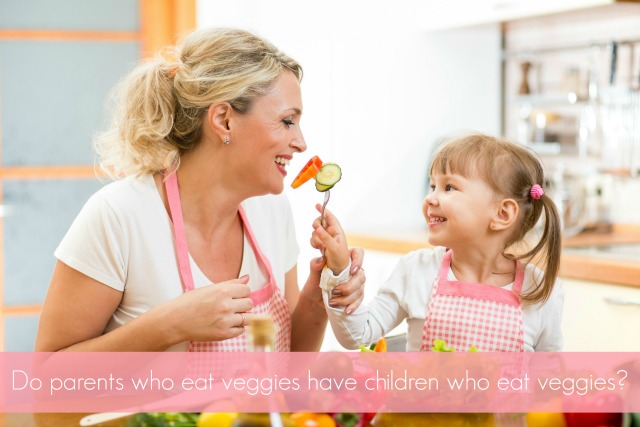Recent studies appear to back what child nutrition experts have been saying all along—the secret to getting kids to eat their greens is to see their parents consuming vegetables as well. However, one reason for this seems to be significantly more complicated than young children simply modeling adults.
Yale psychological scientist Annie Wertz speculates it might be an evolutionary holdover from our early ancestors who relied on gathered plant sources for food, but had to exert caution determining which plants were safe to eat and which were toxic or deadly. Young children, thus, may still carry the biological wiring to be wary of plant food sources.
“Young children’s decisions about what to eat are, famously, not determined by simply copying adult behavior,” Wertz and co-author Karen Wynn note in the paper “Selective Social Learning of Plant Edibility in 6- and 18-Month-Old Infants” published in Psychological Science. Instead Wertz and Wynn hypothesized that children tend to be drawn to specific types of plants, but only after an adult does so.
To test this, Wertz and study co-author Karen Wynn performed four experiments with infants. Researchers observed 18-month olds to see how they distinguish between edible plants and ‘artifacts.’ Artifacts had the shape and texture of plants but did not look like real plants. Dried fruit hung from both the real and artificial plants.
“We predicted that human infants may possess selective social learning strategies that rapidly identify edible plants,” wrote Wertz and study co-author Karen Wynn in their paper “Thyme to touch: Infants possess strategies that protect them from dangers posed by plants,” published in the journal Cognition in January.
Studies Show Infants Eat What They Think is Edible and Safe
An experimenter took a fruit off each plant and pretended to eat it. Then infants were offered a fruit by another experimenter and asked, “Which one can you eat?” Infants strongly preferred fruits from the real plant, even though they received the same social messages. However, if the fruit was placed behind the ear instead of the mouth, infants chose randomly. Even younger children, with no experience with solid food, also preferred real plants.
According to Psychological Science, because infants looked longer at the adults who placed fruit from the fake plants into their mouths, the fruit “violated their expectations for edibility.” Another test was done with the 18-month-olds, where experimenters simply looked at the plant, then artifact, with their hands at their sides and faces neutral, simply saying, “Hmm.” Another experimenter asked the infants which fruit could they eat. The children chose randomly.
A Huffington Post article reports that these findings suggest that, without a model for placing fruit in the mouth, infants “no longer identified the plant as a more likely food source.“ They rely specifically on social cues from adults.
According to Wertz, these experiments demonstrate that “infants use social information from adults to rapidly and selectively identify plants as food sources.” Instinctively, young children know not everything that goes into the mouth is considered food.
Infant ‘Thyme to Touch’
In their paper “Thyme to Touch,” Wertz and Wynn reported on a study observing how infants reacted to a variety of objects while sitting on their parent’s lap (whose eyes were closed shut). Six objects would be placed, one at a time, in front of the child, while the experimenter said, “Look what I’ve got.” Infants were timed for how long it took to grab the object.
On average, infants in these studies took five seconds longer to touch plants than other objects put in front of them. Fake plants also had a slow response time. Wertz and Wynn believe the reluctance may be a behavioral strategy, serving to protect them from the potential dangers of plants—not, as some suggest, that they are afraid of—or simply dislike—leafy greens. The scientists believe adults can reprogram this strategy by showing young children a particular plant is safe to eat or use for another purpose.
Social learning is just one section of the plate for children’s food education and development for what they like or don’t like to eat. However, Wetrz believes that the research findings showing infants propensity toward fruits from edible leafy green plants offers “strategies for getting young children interested in eating novel fruits and vegetables, such as taking them to a ‘pick-your-own’ fruits and vegetables farm.”
Educating Youth About Food and Agriculture
Last week, Sarah Small of Food Tank offered 10 additional ways families can educate youth about plants, nutritious food and agriculture in the UK’s The Telegraph:
- Read books about food—find books that teach children about where food comes from, who grows it, and which foods are both nutritious and delicious.
- Play games that teach food-related topics, then test your smarts with quizzes.
- Encourage farm-to-school and environment-based curricula in schools.
- Engage kids in community gardens and farms.
- Understand the importance of biodiversity, especially as it pertains agriculture and farming.
- Start a school campaign dedicated to food security issues.
- Start a family garden.
- Watch educational programs about the food system—how it works and who creates what.
- Involve kids in meal planning, including bringing them on family trips to farmers markets and grocery stories.
- Establish family meal times.
To read more about these ways to educate your children about food and healthy eating, visit 10 Ways to Teach Your Child to Eat Well at The Telegraph.

Never gave too much thought to why kids eat what they do, beyond the reason that it’s what their parents put in front of them. Interesting article!
Really great article, share with the farmers markets – they would love this one too! Cath